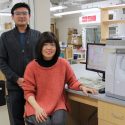Cranberry breeding program may soon bear fruit for growers
A cranberry variety developed by UW–Madison scientists with the help of local cranberry growers is now poised to give those same growers a competitive edge.
The berries of HyRed, a cranberry bred and tested for more than 10 years by UW–Madison plant breeders Eric Zeldin and Brent McCown, turn deeply red a full two weeks sooner than those of a leading cranberry cultivar called Stevens. HyRed’s early and intense fruit color promises to help Midwest growers better compete with East Coast and West Coast cranberry operations that benefit from longer growing seasons.
“Because the Midwest has a shorter growing season and growers have to get the cranberries out before freezing, they’ve many times had to go in and harvest the crop before it developed full color,” says McCown, UW–Madison’s Gottschalk Distinguished Professor of Cranberry Research. “Growers can command a premium price for darker berries, so color is one of the issues of competitiveness for the Midwest.”
Cranberries are particularly big business in Wisconsin: The state currently produces 50 percent of North America’s crop, making Wisconsin the largest cranberry producer in the world.
Given the crop’s regional importance, McCown and Zeldin talked with several local growers when launching UW–Madison’s cranberry research program in the early 1990s. “We wanted to know what research we could do that would be of unique significance to the Midwest,” says McCown.
The scientists decided on boosting the color, or pigment content, of the berries as their first target because color is an easy trait to measure and growers identified it as a key issue. In fact, one grower from Pittsville, Wis., became so involved in developing ideas for the research program that he is listed with Zeldin and McCown on a HyRed patent. The patent was issued in 2003 to UW–Madison’s patent and licensing organization, the Wisconsin Alumni Research Foundation (WARF).
Growers have also played a key role in testing the variety’s performance in the field. After evaluating HyRed for several years in plots in central and northern Wisconsin, in 2001 Zeldin and McCown released the variety to growers for further testing – making HyRed the first publicly available cranberry hybrid in more than three decades.
Since then, the cultivar has been planted in trial beds in over 30 commercial cranberry marshes around Wisconsin, as well as sites in Massachusetts, New Jersey, Oregon and British Columbia.
“The development of HyRed is a good example of participatory plant breeding,” says McCown, “where the eventual recipients (the growers) take part in the initial breeding program by helping to design goals, evaluate new varieties in their fields and fund the research.”
HyRed’s development has been supported, in part, by the Wisconsin Cranberry Board and Ocean Spray, Inc.
As crop plants go, cranberry is relatively undomesticated. Many popular varieties – including Ben Lear, favored in Wisconsin because its fruit also turns red earlier in the season, and Early Black, which Zeldin calls the classic Massachusetts cranberry – were taken directly from wild cranberry bogs and cultivated.
Even the variety Stevens, an easy-to-grow cultivar that constitutes an estimated 60 percent of the cranberry acreage in Wisconsin, is “just one step away from the wild,” says Zeldin – the result of a single round of breeding by the U.S. Department of Agriculture in the early 1930s.
Cranberry’s wild character provides plant breeders with an abundance of genetic variation. So, when Zeldin began the cranberry-breeding effort by crossing Ben Lear with Stevens, he fully expected to see berry shades ranging from light pink to dark red among the 700 progeny he propagated from the cross. Even so, HyRed surprised him.
“HyRed was just unique,” he says. “That particular year, its berries were already red in August, and it had a lot of flower buds,” a promising indicator of high fruit yield. Zeldin has since shown that HyRed produces berries containing up to three times as much red anthocyanin pigment as Stevens. And because its berries color and ripen much earlier, HyRed can be harvested two to three weeks sooner than Stevens – a boon for local growers.
“Originally, we just wanted to combine the good color of Ben Lear with the reproducibility and ease of growth of Stevens,” Zeldin says. “Well, we exceeded that with HyRed.”
To accommodate those growers who may be ready to scale up their pilot HyRed plantings to the commercial level, WARF is now offering reasonably priced licenses that will allow growers to market and sell the cultivar’s fruit. The licenses are required to regulate and protect HyRed’s genetic integrity. All licensing income will return to UW–Madison to support future research.
Tags: biosciences, research



